Warm Winter Woolens:
Scarf Yarns
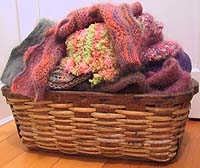
I have a large basket by my front door. In the summer it holds hats covered with mosquito netting—essential for Maine's black fly and mosquito season. In the winter, it holds 20 years' worth of handknit scarves.
They come out in November and don't get put away until April. This is partly because of Maine's notoriously long winters, but partly because I can't resist the womb-like warmth and security of a soft handknit scarf around my neck.
Many in the knitting world share my feelings, and we have no end of scarf books and patterns available. But why do so many of these patterns call for un-neckworthy yarns? It baffles me.
Let's close our eyes and walk through the KR swatch room by touch alone, pulling out the warmest, softest yarns that beg to be wrapped around your neck.
Underscarves
Underscarves are precisely what they sound like: lightweight, super-thin scarves that easily sneak underneath everything else and provide a foundation of warmth.
The classic underscarf is really just a short, narrow (3 to 4 inches wide) rectangle that wraps around your neck once before being tied. It doesn't even need to have a fancy pattern. Just plain stockinette with a garter-stitch border will do. So, depending on yardage, you can often get away with using a single skein of truly fine stuff.
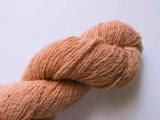 One underscarf yarn that isn't expensive is the single-ply lace-weight yarn from Morehouse Merino. The supersoft merino fibers are pure and unprocessed—so much so, in fact, that you'll be pulling out little bits of vegetable matter as you go. But it produces a fine, soft, and warm underscarf.
One underscarf yarn that isn't expensive is the single-ply lace-weight yarn from Morehouse Merino. The supersoft merino fibers are pure and unprocessed—so much so, in fact, that you'll be pulling out little bits of vegetable matter as you go. But it produces a fine, soft, and warm underscarf.
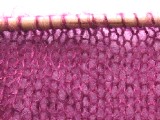 For a truly gossamer underscarf, consider Rowan Kidsilk Haze. Although many mohairs can be scratchy, this yarn features the very finest mohair fibers an angora goat ever produces. They are artfully blended with 30% silk for shimmer and balance, while the mohair fibers loft just enough to hold in the warmth. Each skein has 227 yards, which is more than enough for a single underscarf. Best of all, it's only $12.95 per skein. If you can't find Kidsilk Haze, also consider Knit One, Crochet Too Douceur et Soie.
For a truly gossamer underscarf, consider Rowan Kidsilk Haze. Although many mohairs can be scratchy, this yarn features the very finest mohair fibers an angora goat ever produces. They are artfully blended with 30% silk for shimmer and balance, while the mohair fibers loft just enough to hold in the warmth. Each skein has 227 yards, which is more than enough for a single underscarf. Best of all, it's only $12.95 per skein. If you can't find Kidsilk Haze, also consider Knit One, Crochet Too Douceur et Soie.
Moving up on the price chain, Mountain Colors Cashmere is a delicate, slinky 100% cashmere that knits up at 6 stitches per inch on US 5 needles. If you knit conservatively, you could probably get a very small underscarf from one skein, although two would be safe. And now for the bad news: It retails for $32 per 95-yard skein.
Similar in general feel to Mountain Colors Cashmere is Joseph Galler's Pashmina I and Pashmina II yarns, which retail for $50 and $55 per 170-yard skein, respectively. The grade of cashmere in this yarn is excellent.
If money is no object, you must, of course, use qiviut. Qiviut is the Cadillac of fibers where warmth and softness are concerned.
But I strongly urge you to touch the yarn first, if at all possible. Qiviut is from the fine downy undercoat of the musk ox. It is often jumbled with thicker, coarser guard hairs that must be expertly removed, or dehaired, prior to spinning. And not all processors do as good a job of it.
The more guard hairs in your yarn, the rougher it will be against your skin. A while back I ordered qiviut yarn online and received a hairy, underwhelming hank in the mail. (The yarn in question was since discontinued.) If you must shop online, consider the Oomingmak Musk Ox Producer's Cooperative and Windy Valley Musk Ox. Prepare to pay upwards of $60 per ounce for fingering-weight yarn.
Uberscarves
Your first line of defense against the cold is what I like to call the "uberscarf," the final thing you wrap around you before leaving the house. If you have no underscarf, then your uberscarf needs to be just as soft—but much thicker.
Despite the grandiose name, the uberscarf still should be small enough to enable comfort and movement. If it gets any wider than 8 to 10 inches, it'll fold in half as you wrap it around your neck, and you'll end up with a scarf that could double as a neck brace.
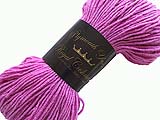 My first vote, encouraged by the fact that I'm currently wearing a scarf of it, is Plymouth Yarns Royal Cashmere. This plush cabled cashmere knits up at 4.5 stitches per inch on US 7 needles and retails for $31.99 per 154-yard hank.
My first vote, encouraged by the fact that I'm currently wearing a scarf of it, is Plymouth Yarns Royal Cashmere. This plush cabled cashmere knits up at 4.5 stitches per inch on US 7 needles and retails for $31.99 per 154-yard hank.
You could conceivably get away with using one hank for a narrow ribbed scarf that only wraps around your neck once, or wraps twice but doesn't tie. I used a skein and a half for a longer skinny K1/P1 ribbed scarf that wraps twice and ties nicely. Each time I wear it the yarn gets softer and more beautiful.
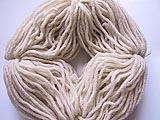 Next on my list would have to be Karabella Yarns' Super Yak, composed of 50% supersoft merino, and 50% yak down. Extremely warm and comparable in fineness to cashmere, the yak down makes this yarn ideal for scarves. It is more affordable than the others, with each 125-yard hank retailing for $20. The yarn knits up at 3 to 3.5 stitches per inch on US 10.5 needles, which means two hanks would give you more than enough yarn for a glorious K1/P1 or K2/P2 or even farrow-ribbed uberscarf.
Next on my list would have to be Karabella Yarns' Super Yak, composed of 50% supersoft merino, and 50% yak down. Extremely warm and comparable in fineness to cashmere, the yak down makes this yarn ideal for scarves. It is more affordable than the others, with each 125-yard hank retailing for $20. The yarn knits up at 3 to 3.5 stitches per inch on US 10.5 needles, which means two hanks would give you more than enough yarn for a glorious K1/P1 or K2/P2 or even farrow-ribbed uberscarf.
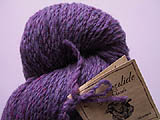 If wool is your thing and you're on a budget, I have three words for you: Beaverslide Dry Goods. From a family ranch along Montana's Rocky Mountain Front, Beaverslide's yarn features a delicious Rambouillet/merino cross that has been minimally processed without any harsh chemicals.
If wool is your thing and you're on a budget, I have three words for you: Beaverslide Dry Goods. From a family ranch along Montana's Rocky Mountain Front, Beaverslide's yarn features a delicious Rambouillet/merino cross that has been minimally processed without any harsh chemicals.
The fibers are dyed and blended before spinning, giving you a delicate range of heathered colors. And then the fibers are spun on an antique spinning mule, which gives the yarn a delicate loft and bloom that begs for a scarf.
The worsted-weight wool/mohair blend retails for $7.50 per 241-yard hank. Since the yarn knits up at 4 to 5 stitches per inch on US 7 or 8 needles, you'll get one mighty uberscarf out of a hank—for less than $8.
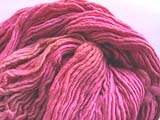 When I reviewed it in early 2005, I said HandPaintedYarn.com's worsted-weight merino yarn was too good to be true. Indeed, the merino is no longer easily available from the Uruguay-based HandPaintedYarn.com (where it retailed for $7.50 per 215-yard hank). Today you'll have to go through their US label, Malabrigo yarn, and pay $12 for the same thing. But even then, the buttery softness and vibrant hand-dyed colors make this yarn entirely worth it—especially for a rustic but supersoft warm winter scarf.
When I reviewed it in early 2005, I said HandPaintedYarn.com's worsted-weight merino yarn was too good to be true. Indeed, the merino is no longer easily available from the Uruguay-based HandPaintedYarn.com (where it retailed for $7.50 per 215-yard hank). Today you'll have to go through their US label, Malabrigo yarn, and pay $12 for the same thing. But even then, the buttery softness and vibrant hand-dyed colors make this yarn entirely worth it—especially for a rustic but supersoft warm winter scarf.
Interestingly enough, the warmest scarves in my basket aren't the ones knit from merino or qiviut, or even the super-thick cashmere. They're the ones made from angora. When the windchill hits -20, my angora scarves are impenetrable.
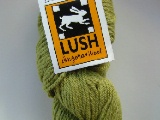 My favorite angora scarf is made from my own handspun angora, but there are still some excellent commercial alternatives out there. Topping the list is a sentimental favorite of mine, Classic Elite Lush. The succulent 50% wool/50% angora blend won't break the bank, with a retail price of $9.95 per 124-yard skein. It knits up at 4.5 stitches per inch on US 8 needles and comes in 21 rich, delicate colors. (Since publishing this article I heard from one reader that she had an unfavorable shedding experience with this yarn. I'll be testing more skeins to see if there's been a shift in quality.)
My favorite angora scarf is made from my own handspun angora, but there are still some excellent commercial alternatives out there. Topping the list is a sentimental favorite of mine, Classic Elite Lush. The succulent 50% wool/50% angora blend won't break the bank, with a retail price of $9.95 per 124-yard skein. It knits up at 4.5 stitches per inch on US 8 needles and comes in 21 rich, delicate colors. (Since publishing this article I heard from one reader that she had an unfavorable shedding experience with this yarn. I'll be testing more skeins to see if there's been a shift in quality.)
If you want more angora in your mix, Anny Blatt Angora Super Yarn is a classic 70% angora/30% wool blend worth serious consideration if warmth and fluff are your desires. It's been produced in France for more than 20 years.
Angora Super comes in a whopping 43 solid colors and 8 coordinating painted ones, retails for $19.95 per 116-yard skein, and knits up at 5.25 stitches per inch on US 5 needles. It's been my experience that angoras of this type will shed more if you knit them too loosely, so I recommend a K1/P1 or farrow rib pattern to help hold in the fibers.
The colors in Louisa Harding's Angora Kimono are stunning, the price reasonable, and best of all, the yarn doesn't shed all over the place when you knit with it.
Lorna's Laces also makes a 70% angora/30% lambswool yarn called Angel that I'm eager to try, partly because of the fiber combination and partly because of the vibrant, nearly edible color combinations.
And, if you're feeling adventurous, consider sampling some luxurious 100% angora directly from Orkney Angora in Scotland, or from its Canada retailer, Irene & Mr. Sheep.
After all, scouting out new sources is half the fun, isn't it? And with a dozen or so of these handknit scarves at your disposal, winter will be a piece of cake.
